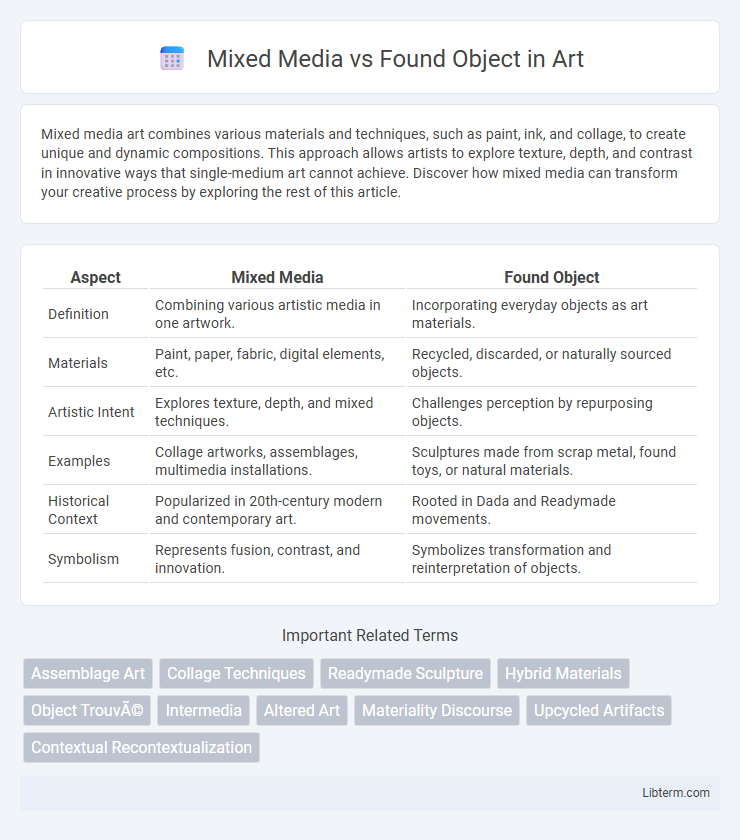Mixed media art combines various materials and techniques, such as paint, ink, and collage, to create unique and dynamic compositions. This approach allows artists to explore texture, depth, and contrast in innovative ways that single-medium art cannot achieve. Discover how mixed media can transform your creative process by exploring the rest of this article.
Table of Comparison
| Aspect | Mixed Media | Found Object |
|---|---|---|
| Definition | Combining various artistic media in one artwork. | Incorporating everyday objects as art materials. |
| Materials | Paint, paper, fabric, digital elements, etc. | Recycled, discarded, or naturally sourced objects. |
| Artistic Intent | Explores texture, depth, and mixed techniques. | Challenges perception by repurposing objects. |
| Examples | Collage artworks, assemblages, multimedia installations. | Sculptures made from scrap metal, found toys, or natural materials. |
| Historical Context | Popularized in 20th-century modern and contemporary art. | Rooted in Dada and Readymade movements. |
| Symbolism | Represents fusion, contrast, and innovation. | Symbolizes transformation and reinterpretation of objects. |
Introduction to Mixed Media and Found Object Art
Mixed media art combines various artistic materials and techniques, such as paint, paper, fabric, and digital elements, to create a single cohesive work that emphasizes texture and depth. Found object art involves incorporating everyday, often discarded items like metal scraps, wood pieces, or plastic components into artwork, transforming these materials into new artistic expressions. Both approaches challenge traditional art boundaries by integrating unconventional materials, fostering innovation and unique visual experiences.
Defining Mixed Media Art
Mixed media art combines various traditional and non-traditional materials such as paint, fabric, paper, and digital elements into a single cohesive artwork. It emphasizes layering and texture to create depth, often blending mediums like acrylics, inks, collage, and metal. Found object art incorporates everyday items not originally intended as art materials, transforming them into visual statements through assemblage and recontextualization.
Understanding Found Object Art
Found object art involves incorporating everyday, pre-existing items into artwork, emphasizing their inherent meanings and histories to create new contexts. This approach contrasts with mixed media, which blends various artistic materials and techniques without necessarily focusing on the original function or significance of the materials. Understanding found object art deepens appreciation for its ability to challenge traditional aesthetics and provoke thought through the transformation of mundane objects into artistic statements.
Historical Origins and Influences
Mixed media art originated in the early 20th century with Cubist artists like Pablo Picasso and Georges Braque experimenting by combining painting and collage. Found object art, or objet trouve, gained prominence through Marcel Duchamp's readymades in the 1910s, challenging traditional art definitions by incorporating everyday objects. Both movements share roots in Dada and Surrealism, emphasizing disruption of conventional aesthetics and exploring new artistic identities.
Key Techniques in Mixed Media
Key techniques in mixed media include layering diverse materials such as acrylics, inks, fabric, and paper to create complex textures and depth. Artists often integrate collage elements, staining, and mark-making to enhance visual interest and convey conceptual themes. This approach contrasts with found object art, which primarily centers on the assemblage of pre-existing physical objects as the primary medium.
Artistic Approaches to Using Found Objects
Mixed media art integrates diverse materials and techniques to create layered visual narratives, often blending paint, fabric, and paper. Artistic approaches to found objects emphasize repurposing everyday items imbued with history or cultural significance, transforming them into compelling focal points or subtle textures within a composition. Found object art challenges traditional boundaries by incorporating elements like discarded metal, wood, or textiles, enriching the conceptual depth and tactile dimension of the artwork.
Materials and Tools: A Comparison
Mixed media art combines various traditional materials such as paint, ink, and fabric with non-traditional supplies like paper, metal, and plastic, allowing artists to explore diverse textures and depths. Found object art primarily utilizes everyday items or discarded materials, transforming objects like wood, glass, and metal into creative compositions without extensive alteration or addition of conventional art tools. While mixed media emphasizes blending multiple art supplies and techniques, found object art centers on recontextualizing physical objects as the core artistic medium.
Creativity and Expression in Both Forms
Mixed media art combines various materials and techniques, allowing artists to explore depth and texture beyond traditional boundaries, fostering limitless creativity and self-expression. Found object art repurposes everyday items, imbuing them with new meaning and narratives, which challenges viewers' perceptions and invites innovative storytelling. Both forms prioritize originality and personal interpretation, enabling artists to communicate complex ideas through tangible, multi-layered compositions.
Notable Artists and Iconic Works
Notable artists in mixed media include Robert Rauschenberg, known for his "Combines" which merge painting and sculpture with everyday objects, and Pablo Picasso, who pioneered collage techniques. Found object art features Marcel Duchamp, famous for his readymades such as "Fountain," a signed urinal that challenged traditional art norms. These iconic works highlight the fusion of diverse materials in mixed media and the transformation of everyday objects into art within the found object movement.
Choosing Between Mixed Media and Found Object Art
Choosing between mixed media and found object art depends on your creative goals and material availability. Mixed media involves combining various artistic mediums like paint, fabric, and paper to create textured, layered works, while found object art repurposes everyday items to form sculptures or assemblages that emphasize narrative and environmental commentary. Consider the desired aesthetic, conceptual depth, and tactile qualities you want to explore when deciding which approach best suits your artistic vision.
Mixed Media Infographic

 libterm.com
libterm.com